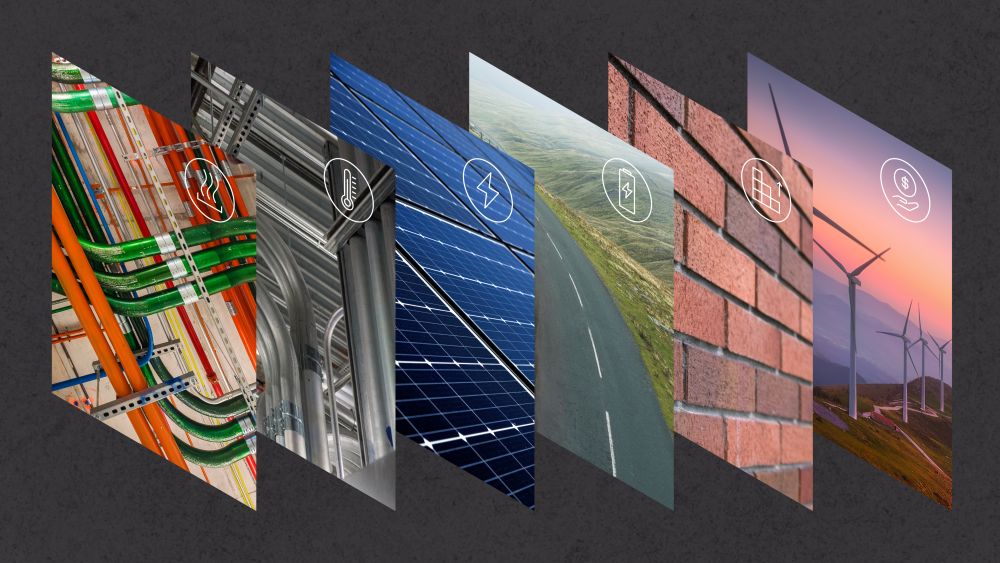How colleges and universities can access federal funding for sustainable campus improvements
Emily Purcell
February 6, 2024
Social Sharing
One thing we hear nonstop lately in the sustainable design world is, “There's so much money out there!” The Bipartisan Infrastructure Law (BIL) and Inflation Reduction Act (IRA) were historic federal investments committing nearly $2 trillion to renewable energy, climate jobs and projects that push polluting fossil fuels out of our communities. But the list of grants, tax credits and other financing tools in those laws can feel like an alphabet soup of acronyms with rules too complex to decipher.
While the BIL and IRA triumphed through tough battles in Congress, the onus now falls upon college and university leaders, designers and builders to unlock their full potential. To illustrate the opportunities, we've created this guide based on a hypothetical private, non-profit university. In this scenario, school leadership has just announced a plan to achieve carbon neutrality by 2050. How can the campus work towards that target and take full advantage of funding opportunities? Here's six pathways to consider.
- Pathway 1: Investment Tax Credit
- Pathway 2: Investment Tax Credit + 179(D) federal tax deduction
- Pathway 3: Production Tax Credit
- Pathway 4: Sustainable vehicle infrastructure credits
- Pathway 5: 45(L) tax credit for energy-efficient homes
- Pathway 6: Significant funding for research into sustainability
Pathway 1:
Investment Tax Credit
The university’s central plant currently burns natural gas to heat campus buildings, and the chiller equipment is aging. A geothermal system could replace this outdated infrastructure and provide highly efficient heating and cooling with a much smaller carbon footprint.
The Investment Tax Credit (ITC) has long provided tax incentives to for-profit businesses that invest in renewable energy systems. Before the IRA, this didn't help non-taxed entities like universities. Under the new version of this tax credit, nonprofits (and public entities) can receive the credit — not on their taxes, but as a direct payment.
Because a new geothermal system is a big upfront investment, the ITC is a great option. At a minimum, the university can get six percent of the geothermal system's cost paid back by the federal government.
Six percent back might not sound like much for such a hefty upfront price. But if the university works with its contractor to ensure that prevailing wages and apprenticeships are implemented during construction that number can jump to 30 percent. Additional location bonuses get tacked on for projects in energy communities and low-income areas, as well as those that select an American manufacturer for the geothermal components.
Pathway 2:
Investment Tax Credit + 179(D) federal tax deduction
There are also plans for a new academic building to be constructed to meet the latest energy code that will connect to the geothermal system mentioned earlier. This sounds like a great contribution to the school's decarbonization efforts, but the design team knows they can push the building's enclosure and systems beyond the current code for a truly deep energy reduction.
The university already earned the ITC funding on its central plant project, but there is still ITC money to secure for this phase of the project. The new building will use a chilled and hot water pipe network hooked up to the central plant. And because the ITC considers downstream equipment and distribution components to be part of a geothermal system, the same credit can be taken for the building's thermal network.
Meanwhile, the design team demonstrated that the building would beat the energy code baseline by 25 percent. The 179(D) federal tax deduction is now earned, starting at $0.50 per square foot. This deduction unfortunately can't be allocated to the nonprofit university, but the design firm can receive it on their behalf. As with the central plant, meeting wage and apprenticeship standards can bump that $0.50 up to $2.50, and additional energy savings will push it even higher. This is a huge incentive for designers to at least study high-efficiency options, and to show that reaching that level of energy savings will maximize utility incentive program payouts to the university.
These incentives can all apply to retrofit projects as well.
Pathway 3:
Production Tax Credit
Another academic building on campus has a large, flat roof and the university has identified it as a prime location for installing solar panels. The panels will generate electricity and store it in a battery, which will supply clean energy overnight or provide an emergency backup.
The ITC can be used to offset the cost of the battery just like it was for the central plant, but the Production Tax Credit (PTC) may be a better option for the solar panels. Like the ITC, this tax credit has been around for many years but expanded dramatically under the IRA, including becoming available to nonprofits as a direct payment.
Once the panels are up and running, the PTC can be taken annually for ten years. The amount is based on how much power was generated that year, starting at 0.55 cents per kilowatt-hour. Again, wage and apprenticeship bonuses and advantages for energy community locations apply, so projects can earn up to 2.81 cents per kilowatt-hour.
The continual use of solar panels is why the PTC can be a better deal than the ITC. Since the university owns the panels long-term, it will receive direct payment year after year. For example, imagine a 10,000-square-foot rooftop solar array in Pittsburgh, PA. Based on Pittsburgh's annual hours of sunlight and its status as an Energy Community, the solar array's owner would earn over $4,700 annually assuming labor requirements are met.
Pathway 4: Sustainable vehicle infrastructure credits
Part of the university's carbon neutrality plan involves reducing reliance on fossil-fueled vehicles, both in the campus fleet and for commuters. Installing electric vehicle chargers in the main parking lot is a key step in enabling this transition.
The IRA introduced some new options for funding charger purchases and installation costs. One is the Charging and Fueling Infrastructure Grant Program, administered by the Department of Transportation. It can cover 80 percent of the cost of new vehicle charging infrastructure. This grant will be issued annually at least through 2027.
The university may also be eligible for the Alternative Fuel Vehicle Refueling Property Credit (30C). Just like the ITC and PTC, this tax credit is issued to nonprofits as a direct payment. Unlike those credits, though, 30C can only be taken for installations in rural (as designated by the Census) or low-income communities. If eligible, the credit starts at 6% of the equipment cost, up to 30% after prevailing wage and apprenticeship bonuses. What's more, it also applies to electric motorbike chargers, not just those for cars and buses. Because the grant and tax credits are aimed at disadvantaged communities, the university may or may not be eligible based on its location. But especially as IRA money works its way down to state governments, state grants and utility rebates are a smart place to look for alternate sources of funds.
As the university expands its fleet, the Commercial Clean Vehicle Credit (45W) applies to newly purchased vehicles. Up to $40,000 or 30% of the vehicle cost is available to tax-exempt entities via direct pay.
Pathway 5:
45(L) tax credit for energy-efficient homes
Student housing needs are growing at this institution, and a private developer proposes building a new residence hall adjacent to the campus. The university asks that the developer follow best practices for energy-efficient design so the residence hall will align with its carbon neutrality target.
The 45(L) tax credit for energy-efficient homes, unlike the ITC and PTC, doesn't have a direct pay option for nonprofits, so our university could not benefit from constructing a new residence hall itself. But in this case, the developer owns the land and hires a contractor to build the project, so the developer can use the tax credit to offset the costs of higher-performance building.
To earn the 45(L) credit, the developer must follow the energy and indoor environment standards outlined in the Energy Star Multifamily New Construction program. The credit applies whether the residence hall includes apartments with full kitchens or dormitory rooms, as both types of units are eligible for the Energy Star Multifamily designation.
By meeting the latest standards for envelope insulation and airtightness, HVAC efficiency, ventilation, and appliance selection, the developer earns a minimum of $500 per unit. Again, that minimum is just a starting point — prevailing wages and deeper energy reductions can raise the credit to $5,000 per unit.
Pathway 6:
Significant funding for research into sustainability
Of course, this campus isn't just a collection of buildings — it's a research university, with students and faculty engaged in important research and community work and partnerships.
Maybe engineering faculty and students are researching wind energy technologies. Or, community service staff are connecting environmental studies students with a community group to monitor pollution in a local neighborhood. Perhaps the university offers job training courses to students looking for work in the clean energy trades.
The IRA and BIL are funding dozens of large and small grants for this type of work. The Department of Energy and Environmental Protection Agency are disseminating these funds with new announcements rolling out regularly. Here's where we've been keeping an eye on:
- EERE Exchange for energy research and development grants.
- EPA's Inflation Reduction Act website for community partnerships funding.
- The American Cities Climate Challenge for a general guide to funding and database of grants.
If you've been reading along from the perspective of our university's administration, you're probably thinking, “Sounds good, but none of this helps me pay for these projects up front.”
This is a gap we're conscious of as we look for opportunities in the federal funding landscape. Most credits and funds discussed are not available until after a project is complete.
While upfront payments aren't well represented in the IRA, there are growing options for loans that can provide capital for green buildings and infrastructure. PACE financing is an established pathway, and even though it is repaid via a tax assessment, nonprofits can typically make use of it.
The IRA also directed significant funding to a Greenhouse Gas Reduction Fund (GGRF) — in other words, setting up not-for-profit "green banks" that will lend federal dollars at low-interest rates or issue grants specifically for clean energy and energy efficiency work. These lending processes are still in development, but we expect to see that money starting to flow in within the next two years. Loans through the GGRF can be repaid using direct payments from the tax credits described above. Even private lenders are expected to offer better terms for green capital, knowing that federal incentives will aid in repayment.
Once a project is complete, a tax professional will take the last steps to secure these credits and funds for an institution such as our university or a developer or design team it partners with. But at the start, it's crucial to work with a design team experienced in exploring, analyzing and implementing deep energy and carbon reduction ideas. In early design stages, modeling can reveal not only the operating energy and emissions impact of design decisions but also what it will take to trigger IRA credits and reach the highest possible payback.
Interested in learning more about federal funding opportunities? Reach out.








